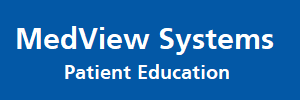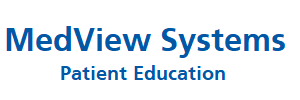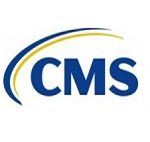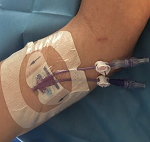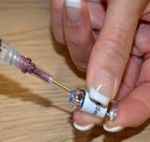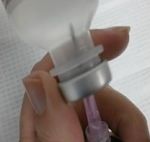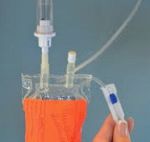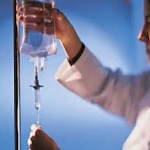
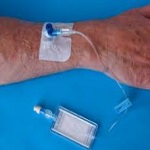
IV Antibiotic Therapy
Many patients who are hospitalized for intensive intravenous (IV) antibiotic therapy of serious infections are not disabled. Following a short period of treatment in the hospital and after their medical problem has stabilized, these patients can safety receive IV antibiotics at home. Intermate infusion system method With these video capsules, at home, you will be able to review the different steps in administering intravenous antibiotics, as instructed by the nurse from the Day Medicine Unit according to your prescribed treatment.
Intravenous antibiotics are antibiotics that are administered directly into a vein so that they can enter the bloodstream immediately and bypass the absorption in the gut. It is estimated that more than 250,000 patients in the US receive outpatient IV antibiotics to treat bacterial infections.
Guidelines, Specifications & User Manuals
IV Antibiotic in Non Hospital Setting
Helpful Information
Many patients who are hospitalized for intensive intravenous (IV) antibiotic therapy of serious infections are not disabled. Following a short period of treatment in the hospital and after their medical problem has stabilized, these patients can safety receive IV antibiotics at home.
Many people have asked us about receiving antibiotics through an IV. We thought that this post would be helpful for our community and we wanted to help shed some light on IV antibiotics. Please feel free to email us with anything else that you would like to learn about.
WHY DO PEOPLE RECEIVE ANTIBIOTICS THROUGH IV’S?
Depending on what type of antibiotic your doctor prescribes, they may need to be administered through an IV. Antibiotics administered through IVs are called Intravenous Antibiotics and are injected directly into the blood. They also give patients an uninterrupted dose of medication along with the ability to bypass the gastrointestinal tract. Additionally, some people require high doses of antibiotics that cannot be taken orally. IV antibiotics are the most effective way to directly receive treatments for infections in the lungs, bones and brain because they are delivered directly into the bloodstream allowing them to reach the infection site more quickly and efficiently which promotes a speedier healing time. According to the National Library of Medicine, IV administration may be used for other treatments including treatment for hormone deficiencies, chemotherapy, medicine for severe nausea resulting from chemotherapy treatments, or patient-controlled analgesia or PCA (pain).
HOW DO PEOPLE RECEIVE TREATMENT?
Treatment is quite simple given a basic understanding of how to do so and with training from the hospital nursing staff. First, you assemble all the parts needed and remember to always keep a sterile environment, which means being very careful of your surroundings. Then, prepare the administrative set to connect to your IV by setting the drip rate to “off” in order to ensure no spills. There are two insertion sites on the IV package, one is for needle insertion and the other is a removable plug. Once connected, fill the drip chamber until the marked line so that you may start priming the administration line. You need to purge the air from the line with the saline solution by opening the dial on the line. It is then that you connect the IV line to the administration set to begin. The medicine can be given either with a slow infusion (over a period of time) or with a fast bolus (all at once). When the IV is placed on the IV poles, an IV “drip” is usually started. A drip is a constant flow of sterile liquid from a bag hanging above the patient. The liquid is often a saline (salt) solution. Other medications can be added to this saline solution, and infused into the blood slowly over time. Sometimes a pump is attached to the IV line and pumps liquid into the catheter in a very slow, steady fashion. Please note that these steps may vary depending on your medicine so please follow the guides your nurse or doctors provides.
WHAT ARE SOME GENERAL GUIDELINES THAT YOU SHOULD FOLLOW WHEN RECEIVING/ADMINISTERING TREATMENT THROUGH A PICC LINE?
- Always wear medical or latex gloves when touching and administering the medication.
- Be sure to keep your gloves clean at all times and constantly wash them.
- Wipe your worksite well before setting up for IV care. Use alcohol or soap and water.
- Put supplies on a clean cloth or on a fresh paper towel.
- Wash your hands with warm water and liquid soap. Scrub for 1 minute. Wash between your fingers. Rinse well.
- Dry your hands with a fresh paper towel and use it to turn off the water so that you do not touch a dirty surface after washing. Set the paper towel aside, and throw it away after the IV care is done.
- Wipe all injection sites with alcohol prep before injection.
- Wipe the PICC line opening with alcohol before attaching it to the IV.
- Hang the IV bag. The drip chamber should be at least 18 inches above your head.
- Always clean the catheter port with an alcohol wipe before use.
- Flush the catheter with saline or heparin as directed by your nurse.
- Attach the IV tubing to your catheter and secure with tape.
- Start the medication as directed by your doctor.
MAKE SURE YOU ARE VERY CAREFUL AND WATCH FOR THESE PROBLEMS:
A puncture hole in the skin around the IV — medicine or fluid can go into the tissue around the vein. This could harm your skin or tissue.
Swelling of your vein (different vein colors, discoloration of the skin)– this can lead to a blood clot (called thrombophlebitis).
THESE RARE PROBLEMS MAY CAUSE BREATHING OR HEART PROBLEMS:
- Air Embolism: A bubble of air gets into the vein and travels to your heart or lungs
- An allergic or other serious reaction to the medicine
- Most times home health care nurses are available 24 hours a day. If you have a problem with your IV or any of the above symptoms, call your doctor or home health care agency immediately for help.
IF THE IV COMES COMPLETELY OUT OF YOUR VEIN:
- First, put pressure over the opening where the IV was until the bleeding stops.
- Then call your home health care agency or your doctor right away.
- CALL YOUR DOCTOR OR NURSE IF YOU HAVE THESE SIGNS OF INFECTION:
- Redness, swelling, or bruising at the site where the needle enters the vein
- Pain
- Bleeding
- Fever over 100.5 °F (38.0 °C)
- CALL 9-1-1 RIGHT AWAY IF YOU HAVE:
- Any breathing problems
- A fast heart rate
- Dizziness
- Chest pain
MANY PEOPLE WONDER WHAT COULD GO WRONG. WHAT ARE SOME COMPLAINTS ABOUT IV ANTIBIOTICS? WHAT ARE SOME ISSUES TO WORRY ABOUT FOR IV ANTIBIOTICS?
One common complaint of using IV antibiotics is the pain and irritation around the IV site. In some cases, patients require strong dosage of medication, like Vancomycin, that can burn as it runs through the veins. Thus, healthcare providers must be more careful and mindful of a patient experiencing pain and irritation at the IV site. When experiencing pain at the IV site, it’s important that the patient also specifies what type of pain is present because a poorly inserted IV can lead to a leakage of medication. When medication is leaking out of the vein, it can damage the surrounding tissues. If this happens the site can appear swollen and red, and is extremely painful, which in turn means that a new IV needs to be inserted.
Patients with poor peripheral veins often utilize something called PICC lines (Peripherally Inserted Central Catheters), where medication is administered directly to the heart. Of all of the types of central lines, this is the most commonly used. There are not many cases where PICC line users report burning of the vein because there isn’t much interaction between the medication and the peripheral veins. One of the common complaints from patients with PICC lines is the fact that treatments usually last for long periods of time. During the long duration of treatment, some patients may find it annoying to keep the PICC line in for several weeks to months at a time. PICC lines must be flushed daily, their dressings have to be inspected and changed, and patients with PICC lines must avoid getting them wet or dirty. The good thing about PICC lines is that you can be sent home with them and the medicine can be administered in your home, which decreases the number of trips to and from the hospital.
A major point to remember with any type of central line is that the insertion site requires better protection due to the higher risk of serious infection if bacteria travel up the catheter to the heart. Due to the fact that the PICC line travels directly to the heart, any type of infection that arises can pose a serious problem. However, a PICC poses less of a systemic infection risk than other central IVs, because the insertion site is usually cooler and dryer than the sites typically used for IV sites. Damp, warm environments encourage the growth of bacteria, which could reach the bloodstream by traveling under the skin along the outside of the catheter. Insertion must also be precise and handled with care, so practitioners must maintain an ascetic technique of insertion. The PICC line is inserted and then threaded through a relatively small peripheral vein which can take a less predictable course on the way to the superior vena cava and is therefore somewhat more time consuming and more technically difficult to place in some patients. PICC lines do have some risks. They can clot, break, or become dislodged. Because they sit in large blood vessels directly above the heart, any bacteria that are inadvertently introduced into the catheter go directly to the heart and are pumped throughout the body, which can lead to a dangerous infection called sepsis.
Related Devices
Medicare Information – CMS
Medicare - CMS Information The Centers for Medicare & Read more...
Instructions for Catheters
Instructions for Catheters and Supplies Intravenous Read more...
Drawing Up Medication from an Ampule
Drawing up medication from an ampule An ampoule (also Read more...
Reconstitution of Powdered Medication
Reconstitution of Powdered Medication Medication Reconstitution: Using the Read more...
Intravenous Antibiotic Treatment
IV Antibiotic Therapy Many patients who are Read more...
IV Piggy Back Procedure Instructions
IV Piggy Back Procedure: Hanging Read more...
Patient Learning Center
